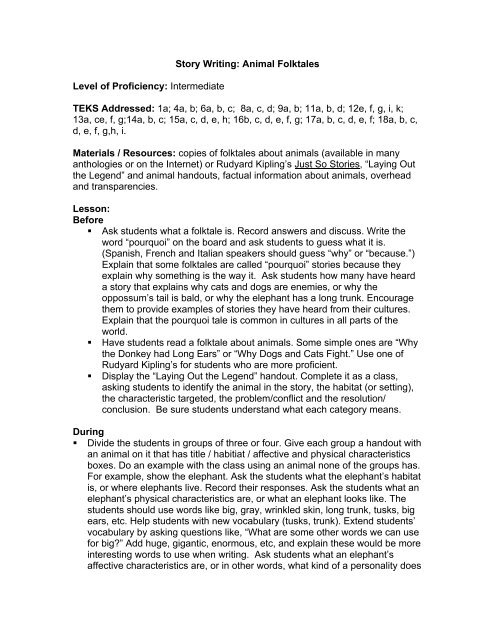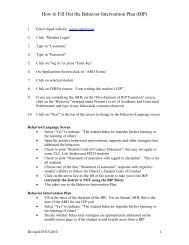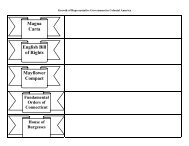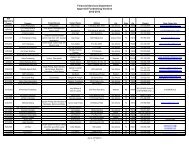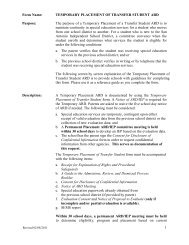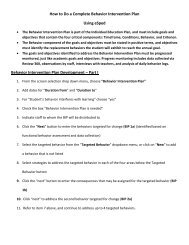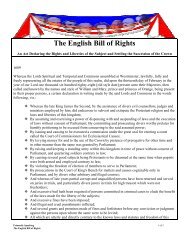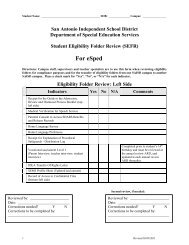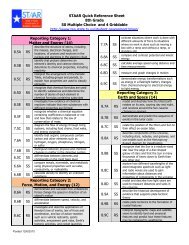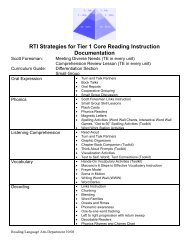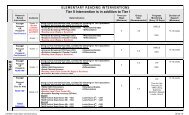Story Writing: Animal Folktales Level of Proficiency: Intermediate ...
Story Writing: Animal Folktales Level of Proficiency: Intermediate ...
Story Writing: Animal Folktales Level of Proficiency: Intermediate ...
Create successful ePaper yourself
Turn your PDF publications into a flip-book with our unique Google optimized e-Paper software.
<strong>Level</strong> <strong>of</strong> Pr<strong>of</strong>iciency: <strong>Intermediate</strong><br />
<strong>Story</strong> <strong>Writing</strong>: <strong>Animal</strong> <strong>Folktales</strong><br />
TEKS Addressed: 1a; 4a, b; 6a, b, c; 8a, c, d; 9a, b; 11a, b, d; 12e, f, g, i, k;<br />
13a, ce, f, g;14a, b, c; 15a, c, d, e, h; 16b, c, d, e, f, g; 17a, b, c, d, e, f; 18a, b, c,<br />
d, e, f, g,h, i.<br />
Materials / Resources: copies <strong>of</strong> folktales about animals (available in many<br />
anthologies or on the Internet) or Rudyard Kipling’s Just So Stories, “Laying Out<br />
the Legend” and animal handouts, factual information about animals, overhead<br />
and transparencies.<br />
Lesson:<br />
Before<br />
Ask students what a folktale is. Record answers and discuss. Write the<br />
word “pourquoi” on the board and ask students to guess what it is.<br />
(Spanish, French and Italian speakers should guess “why” or “because.”)<br />
Explain that some folktales are called “pourquoi” stories because they<br />
explain why something is the way it. Ask students how many have heard<br />
a story that explains why cats and dogs are enemies, or why the<br />
oppossum’s tail is bald, or why the elephant has a long trunk. Encourage<br />
them to provide examples <strong>of</strong> stories they have heard from their cultures.<br />
Explain that the pourquoi tale is common in cultures in all parts <strong>of</strong> the<br />
world.<br />
Have students read a folktale about animals. Some simple ones are “Why<br />
the Donkey had Long Ears” or “Why Dogs and Cats Fight.” Use one <strong>of</strong><br />
Rudyard Kipling’s for students who are more pr<strong>of</strong>icient.<br />
Display the “Laying Out the Legend” handout. Complete it as a class,<br />
asking students to identify the animal in the story, the habitat (or setting),<br />
the characteristic targeted, the problem/conflict and the resolution/<br />
conclusion. Be sure students understand what each category means.<br />
During<br />
Divide the students in groups <strong>of</strong> three or four. Give each group a handout with<br />
an animal on it that has title / habitiat / affective and physical characteristics<br />
boxes. Do an example with the class using an animal none <strong>of</strong> the groups has.<br />
For example, show the elephant. Ask the students what the elephant’s habitat<br />
is, or where elephants live. Record their responses. Ask the students what an<br />
elephant’s physical characteristics are, or what an elephant looks like. The<br />
students should use words like big, gray, wrinkled skin, long trunk, tusks, big<br />
ears, etc. Help students with new vocabulary (tusks, trunk). Extend students’<br />
vocabulary by asking questions like, “What are some other words we can use<br />
for big?” Add huge, gigantic, enormous, etc, and explain these would be more<br />
interesting words to use when writing. Ask students what an elephant’s<br />
affective characteristics are, or in other words, what kind <strong>of</strong> a personality does
an elephant have? Some answers might include loyal, has a long memory,<br />
and faithful. Model selecting one characteristic, such as a long trunk, and<br />
thinking about how the elephant got his trunk. Did he get his nose stuck in a<br />
tight place? Did his parents pull his nose as punishment, and it stretched?<br />
Was he too lazy to get up to get food, so decided to stretch his nose to reach<br />
farther? Write the title: “How the Elephant Got Its Long Trunk.”<br />
In groups, students do the same process with the animal they have. Be sure<br />
they have dictionaries and thesuaruses to help with vocabulary. Encourage<br />
them to draw on prior knowledge and stories from their cultures to contribute.<br />
Circulate and review students’ ideas as they work.<br />
When all groups have the handouts completed, display the “Laying Out the<br />
Legend” handout and model prewriting the story about the elephant below.<br />
Give students the “Laying Out the Legend” handout, and have each group<br />
complete the handouts for their animals.<br />
Model using the information on the handout to write the story about the<br />
elephant. Remind students folktales <strong>of</strong>ten start with “Once upon a time…”<br />
“Many years ago…” “A long , long time ago in a far away place…” (You may<br />
need to review how we use “ago” - this sometimes confuses ELLs because<br />
the structure is different in other languages.)<br />
Many years ago in a faraway place in Africa, an elephant named<br />
Pepito Nuñez lived with his family. In those days, elephants had<br />
very short noses. They had no hands and fingers, so it was difficult<br />
to grab food. Elephants eat all the time, so Pepito and his family<br />
were always walking around to get food. Pepito was very lazy,<br />
and got tired <strong>of</strong> getting up and walking around to eat. He<br />
decided to think <strong>of</strong> a better way. He saw how the giraffe with the<br />
long neck was able to get food from very high trees. He got an idea!<br />
He would stretch his neck like the giraffe. He found two trees that<br />
were close together and put his head between them. He stepped<br />
back and tried to stretch his neck, but it hurt! Worse, his head got<br />
stuck. He had to yell for his mother to come and explain why his<br />
head was between two trees. She got him out and sent him to bed<br />
with no dinner.<br />
Pepito decided to try something different. He found a little hole in<br />
the ground where some tree roots were. It was just the right<br />
size to put his nose in. Everyday he went to the hole, put his<br />
nose in, and pulled for a little while. After many months, he<br />
noticed his nose was growing longer. He exercised it, and<br />
practiced picking things up with it. After a few years, his nose<br />
had grown into a trunk like elephants have today, and he was<br />
able to grab food without walking around so much. The other<br />
elephants saw Pepito and thought he had a good idea, so they<br />
stretched their noses too. Since then, elephants have had long<br />
trunks.
Point out how you included and extended the information in the prewriting<br />
handout to write the story (indicated in bold). Have students in their small<br />
groups develop their stories.<br />
Have students edit and revise as needed, and present their stories to the<br />
class.<br />
Have students select an animal and develop a pourquoi story independently,<br />
using the process modeled and done in small groups.<br />
After<br />
Introduce idioms, similes and metaphors about animals. Sly as a fox, quiet as<br />
a mouse, quick as a rabbit, stubborn as a mule, slow as a turtle, “when the<br />
cat’s away, the mice will play,” “an elephant never forgets” are some<br />
examples common in English.<br />
Find pourquoi tales to read aloud to the class such as Anansi stories from<br />
Africa, or coyote folktales from Mexico and Native America.
Scrapbook Matrix<br />
Directions: Brainstorm objects, peoplem places actions, and feelings you<br />
find in the work. Write down your answers below.<br />
Objects and People<br />
Places<br />
Actions<br />
Feelings
Sample list <strong>of</strong> ideas for scrapbook<br />
“Ex -Basketball Player” by Joh Updike<br />
Rejection letter from college teams<br />
Newspaper article <strong>of</strong> Flick’s games<br />
Love letters or fan mail from girls<br />
Flic’s report card<br />
Luncheonette menu<br />
Yearbook entries<br />
Letter from a college friend<br />
Advertsisements from the garge with specials<br />
Garage price list<br />
Post cards<br />
Interior monologue on the night <strong>of</strong> the big game<br />
Resume for Flick<br />
Gas station repair bills<br />
Timeline <strong>of</strong> Flick’s life<br />
High school reunion invitation<br />
Desription or plan <strong>of</strong> town<br />
Journal entries from an away game<br />
Letter to a friend describing a game<br />
WWII memiors from a a friend or relative<br />
Sample <strong>of</strong> Flick’s writing from school<br />
High school picture<br />
Trophy or medal<br />
Collage <strong>of</strong> sports activities<br />
Drawing <strong>of</strong> pinball machine<br />
Drawing <strong>of</strong> basketball uniform<br />
Advertisement for tools<br />
Basketball card with statistics for Flick


